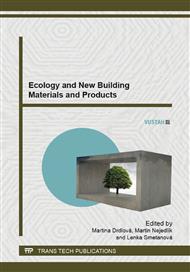[1]
B. Ahmedi, M. Shekarchi Use of natural zeolite as a supplementary cementitious material, Cement and Concrete Composites, Volume 32, Issue 2 (2010), p.134.
DOI: 10.1016/j.cemconcomp.2009.10.006
Google Scholar
[2]
E.A. Ortega, C. Cheeseman, J. Knight, M. Loizidou Properties of alkali-activated Clinoptilolite, Cement and Concrete Research, Volume 30, Issue 10 (2000), p.1641.
DOI: 10.1016/s0008-8846(00)00331-8
Google Scholar
[3]
C.S. Poon, L. Lam, S.C. Kou, Z.S. Lin A study on the hydration rate of natural zeolite blended cement pastes, Cement and Concrete Research, Volume 13, Issue 8 (1999), p.427.
DOI: 10.1016/s0950-0618(99)00048-3
Google Scholar
[4]
C. Colella Natural zeolites, Studies in Surface Science and Catalysis, Volume 157, (2005), p.33.
Google Scholar
[5]
M. M. Ranjbar, R. Madandoust, S. Y. Mousavi, S. Yosefi, Effects of natural zeolite on the fresh and hardened properties of self-compacted concrete, Construction and Building Materials, Volume 47, (2013), p.806.
DOI: 10.1016/j.conbuildmat.2013.05.097
Google Scholar
[6]
M. Valipour, M. Yekkalar, M. Shekarchi, S. Panahi Environmental assessment of green concrete containing natural zeolite on the global warming index in marine environments, Journal of Cleaner Production, Volume 65 (2014), p.418.
DOI: 10.1016/j.jclepro.2013.07.055
Google Scholar
[7]
EN 12350-2 Testing fresh concrete - Part 2: Slump-test.
Google Scholar
[8]
EN 12350-7 Testing fresh concrete - Part 7: Air content - Pressure methods.
Google Scholar
[9]
EN 12390-3 Testing hardened concrete - Part 3: Compressive strength of test specimens.
Google Scholar
[10]
EN 12390-5 Testing hardened concrete - Part 5: Flexural strength of test specimens.
Google Scholar
[11]
EN 12390-8 Testing hardened concrete - Part 8: Depth of penetration of water under pressure.
Google Scholar


